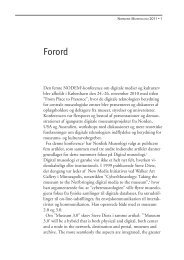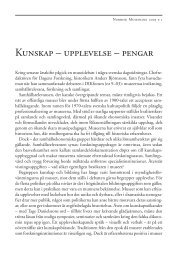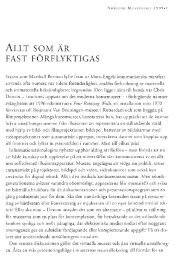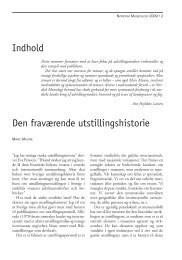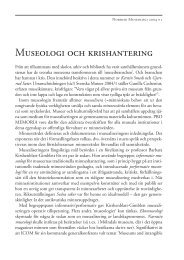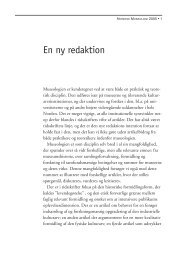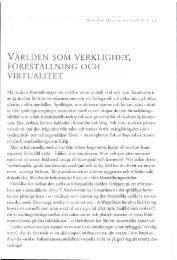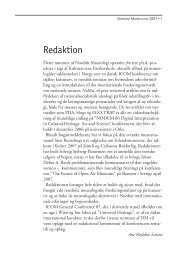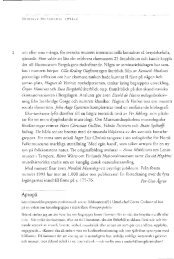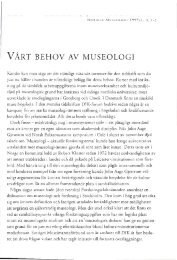ANMÄLAN - Nordisk Museologi
ANMÄLAN - Nordisk Museologi
ANMÄLAN - Nordisk Museologi
You also want an ePaper? Increase the reach of your titles
YUMPU automatically turns print PDFs into web optimized ePapers that Google loves.
CHRISTIAN JORGENSEN THOMSENS MUSEUM - EN GULDALDERSVISION<br />
nok, at han med disse udtalelser ville støde<br />
an mod den herskende klasse. Men, sagde<br />
han, "Sandheden vil engang komme til sin<br />
ret." Nu f. eks. alle disse både fra<br />
Grønland. "Mon ikke der kommer en Dag,<br />
hvor vi roligt kan se på, om vi har en Baad<br />
mere eller mindre fra Grønland".<br />
Tscherning slutter med fyndigt at sige:<br />
"Det er ikke Kajakker vi lever af". Endnu<br />
hundrede år senere kunne man høre de<br />
samme toner i det danske folketing. Det<br />
var i 1950erne, da finansudvalgsformanden<br />
Jensen Broby talte om "indianderragelset"<br />
på Nationalmuseet.<br />
Men museet stod der takket være<br />
Thomsen - og det blev trods alt stående.<br />
Men Thomsens fornemme helhedssyn,<br />
hans guldaldervision, afvikledes efterhånden.<br />
Det blev gjort af en forskning, der<br />
havde den positivistiske empiri som det<br />
eneste videnskabelighedskriterium. Men<br />
mon ikke museet i dag kunne have behov<br />
for at søge tilbage til den fortrængte helhedstænkning,<br />
som knytter de humanistiske<br />
fag sammen. Hvis vi da har ønsket om<br />
at være andet end historisk underholdning.<br />
Det er her, Thomsens vision kan bruges,<br />
ikke som en gentagelse men som en endnu<br />
levende inspiration.<br />
SUMMARY<br />
Christian jurgensen Thomsen': Museum - a Vision of the<br />
Golden Age<br />
The foundation of the National Museum in Copen-<br />
hagen in 1807 was a late result of the Danish cultural<br />
policy at the end of the Enlightenment period. The<br />
inspiration came from France, primarily from<br />
Alexandre Lenoir's Musée des Monuments Francais<br />
established in 1793 and from the Musée Napoleon<br />
opened in 1804 in the Louvre, both of them didacti-<br />
cally arranged art collections open to the public. A<br />
major step in the development of the Danish National<br />
Museum was, however, taken in [816 when a young,<br />
prosperous businessman, Christian Jiirgensen<br />
Thomsen (1788-1865). look over the management of<br />
the collections on a full-time basis. In 1819 he was also<br />
able to open the doors of the museum and admit the<br />
public to the new didactic arrangement of the collecti-<br />
ons. Thomsen knew how to attract the general public<br />
with his lively guided tours. But he was also a brilliant<br />
scholar. Through systematic study of the ancient artefacts<br />
which were delivered to the museum, he arrived<br />
at the conviction, as early as the 1820s and before any-<br />
one else in Europe, that prehistory could be divided up<br />
into a Stone Age, a Bronze Age and an Iron Age.<br />
Thomsen's work took place during the first half of<br />
the 19ch century, a period which in Denmark has later<br />
been called the Golden Age. Culturally it was a very<br />
rich period which also saw the reorganisation of the<br />
many museum collections in Copenhagen - and<br />
Thomsen became the director of most of them. He had<br />
a thorough knowledge of European museum develop-<br />
ment at that time, of the contemporary museums in<br />
Britain and on the Continent: the British Museum in<br />
London, the Altes Museum in Berlin and the<br />
Glyptotek in Munich, all of them built in the neo-clas-<br />
sical style so characteristic of the bourgeois culture. In<br />
contrast to other European cities Copenhagen did not<br />
sec the erection of any neo-classical museum temple.<br />
However, at the end of the I840's most of Thomsen's<br />
collections were moved ro the 'Prinsens Palæ' (the<br />
Crown Prince's Palace), a beautiful 18th century rococo<br />
palace in the heart of Copenhagen<br />
where they arc still housed. Here he created a universal<br />
museum comprising an ethnographical collection, a<br />
coin collection side by side with prehistoric and histori-<br />
cal collections.<br />
Thomsen's museum concept was typical of the evol-<br />
utionism of the Golden Age. His arrangement of the<br />
collections reflected his own evolutionary ideas which<br />
saw mankind developing trough identical evolutionary<br />
stages throughout the world. His museum became<br />
immensely popular with the public and acquired a repu-<br />
29



